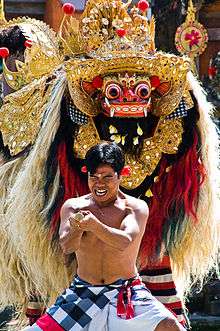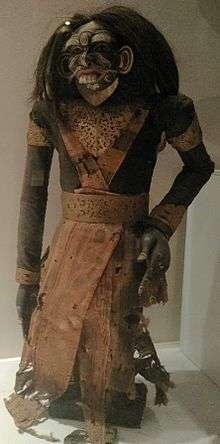Barong (mythology)
| Barong (mythology) |
|---|
 Barong and kris-wielding dancer |
|
| Burma |
| Cambodia |
| Indonesia |
| Laos |
| Malaysia |
| Philippines |
| Thailand |
| Vietnam |
Barong is a lion-like creature and character in the mythology of Bali, Indonesia. He is the king of the spirits, leader of the hosts of good, and enemy of Rangda, the demon queen and mother of all spirit guarders in the mythological traditions of Bali. The battle between Barong and Rangda is featured in Barong dance to represent the eternal battle between good and evil.[1]
Origin
Barong animal mask dance, together with sanghyang dance are considered native Balinese dances, predating Hindu influences. The native Indonesians of Austronesian heritage often has similar mask dances that represent either ancestral or natural spirits; an example is Dayak's Hudoq dance. The term barong derives from the local term bahruang, which today corresponds to Indonesian word beruang which means "bear".[2] It refers to a good spirit, that took the form of an animal as the guardian of forest.
In Balinese mythology, the good spirit is identified as Banas Pati Raja. Banas Pati Raja is the fourth "brother" or spirit child that accompanies a child throughout their life, which is a similar concept to guardian angels. Banas Pati Raja is the spirit which animates Barong. A protector spirit, he is often represented as a lion. The Barong is often portrayed accompanied by two monkeys.
Barong is portrayed as a lion with red head, covered in white thick fur, and wearing gilded jewelry adorned with pieces of mirrors. The shape of lion Barong is somewhat similar to a Pekingese dog. The origins of the Barong are far a back in time and quite uncertain. Its origins could be from animist worship, before Hinduism appeared, when villagers still believed in the supernatural protective power of animals.[3]
Calon Arang
On the other hand, Rangda is Barong's opposite. While Barong represents good, Rangda represents evil. Rangda is known as a demon queen, the incarnation of Calon Arang, the legendary witch that wreaked havoc in ancient Java during the reign of Airlangga in the 10th century. It is said that Calon Arang was a widow, powerful in black magic, who often damaged farmer's crops and caused disease to come. She had a girl, named Ratna Manggali, who, though beautiful, could not get a husband because people were afraid of her mother. Because of the difficulties faced by her daughter, Calon Arang was angry and she intended to take revenge by kidnapping a young girl. She brought the girl to a temple to be sacrificed to the goddess Durga. The next day, a great flood engulfed the village and many people died. Disease also appeared.
King Airlangga, who had heard of this matter, then asked for his advisor, Empu Bharada, to deal with this problem. Empu Bharada then sent his disciple, Empu Bahula, to be married to Ratna. Both were married with a huge feast that lasted seven days and seven nights, and the situation returned to normal. Calon Arang had a book that contained magic incantations. One day, this book was found by Empu Bahula, who turned it over to Empu Bharada. As soon as Calon Arang knew that the book had been stolen, she became angry and decided to fight Empu Bharada. Without the help of Durga, Calon Arang was defeated. Since she was defeated, the village was safe from the threat of Calon Arang's black magic.
Rangda

Another version holds that Rangda was actually linked to historical queen Mahendradatta or Gunapriyadharmapatni, a Javanese princess sister of Dharmawangsa of East Javanese Isyana Dynasty of late Medang Kingdom period. She was the queen consort of Balinese king Udayana and Airlangga's own mother. Mahendradatta is known for her devotion to the worship of Durga in Bali. The story goes that Mahendradatta, the mother of Airlangga, was condemned by Airlangga's father because she practiced black magic. After she became a widow (Rangda in old Javanese means: 'widow'), hurt and humiliated, she sought revenge upon her ex-husband's court and whole of his kingdom. She summoned all the evil spirits in the jungle, the leyaks and the demons that caused plague and death in the kingdom. Airlangga face his own mother to save the kingdom. A fight occurred, but she and her black magic troops were so powerful that Airlangga had to ask for the help of spirit king, Barong in order to defeat her. Barong came with Airlangga's soldiers, and the fight ensued. Rangda cast a spell that made Airlangga soldiers all want to kill themselves, pointing their poisoned keris into their own stomachs and chests. In response, Barong cast a spell which caused the soldiers body's to be resistant to the sharp keris. At the end, Barong won, and Rangda ran away.[1]
Barong dance

The lion is the popular one, as it comes from the Gianyar region, where Ubud (the home of tourist's Balinese dance ritual viewing) is located. Within the calon arang, the dance drama in which the Barong appears, the barong responds to Rangda's use of magic to control and kill her to restore balance. In traditional Barong dance performances, he is portrayed in his struggles against Rangda, it is the popular part of Balinese culture. The mythical creature would dance along the street to the calon arang dance. A priest would throw holy water at it.
- The dance opens with two playful monkeys teasing Barong in a peaceful environment.
- The next scene is popularly known as "Keris Dance". The Rangda character appears and wreaks havoc. She casts black magic upon male dancers, who represent Airlangga's soldiers, and orders them to commit suicide. In a trance, these men stab themselves on their chest with their own kris. Meanwhile, Barong and the priest cast protective magic on these men, which makes them invulnerable to sharp objects.
- The dance ends with the final battle between Barong and Rangda, concluding with the victory of Barong over Rangda. Rangda runs away, the evil is defeated, and the celestial order is restored.
Variations

The lion barong is one of five traditional Barongs. In Bali each region of the island has its own protective spirit for its forests and lands. Each Barong for each region is modeled after a different animal. They are:
- Barong Ket: lion barong, the most common Barong, it is the symbol of a good spirit.
- Barong Landung: giant barong, the form is similar to Betawi Ondel-ondel
- Barong Celeng: boar barong
- Barong Macan: tiger barong
- Barong Naga: dragon (or serpent) barong
See also
Notes
- 1 2 indo.com (2001). "The Barong Dance of Bali". indo.com. Retrieved 2012-01-17.
- ↑ "Tari Barong" (in Indonesian). Kebudayaan Indonesia. 24 March 2014. Retrieved 27 March 2015.
- ↑ "Barong ket (banaspati rajah)". MASCASIA. MASCASIA. Retrieved 29 April 2013.
References
- Lansing, J. Stephen (1995). The Balinese. San Diego: Harcourt Brace College Publishers. ISBN 978-0-15-500240-1.
| Wikimedia Commons has media related to Barong. |
.svg.png)
